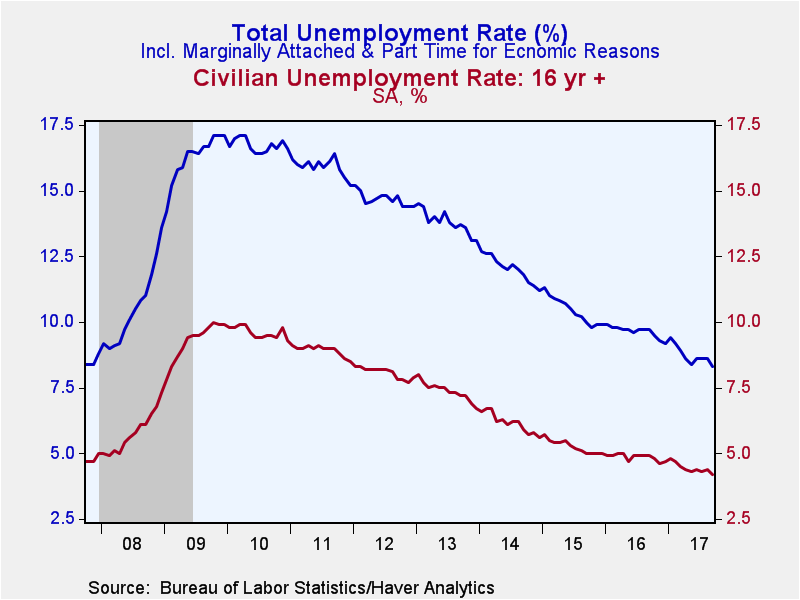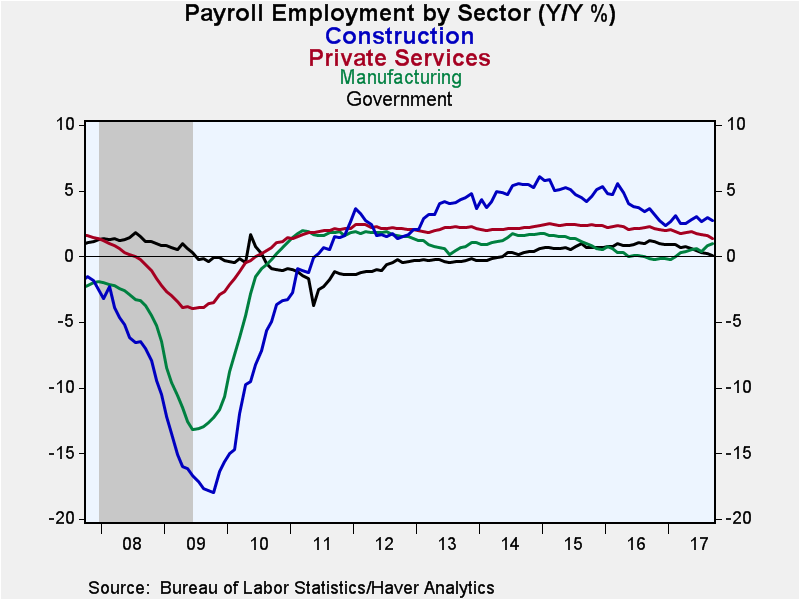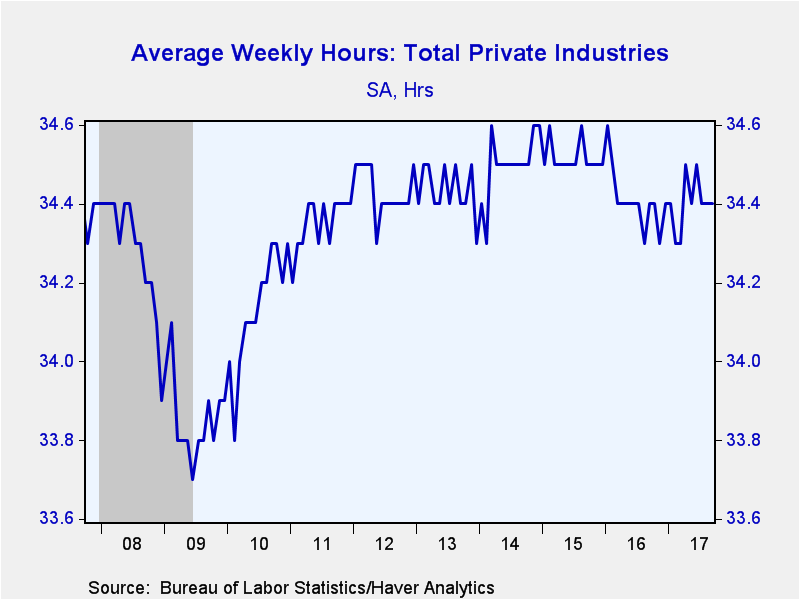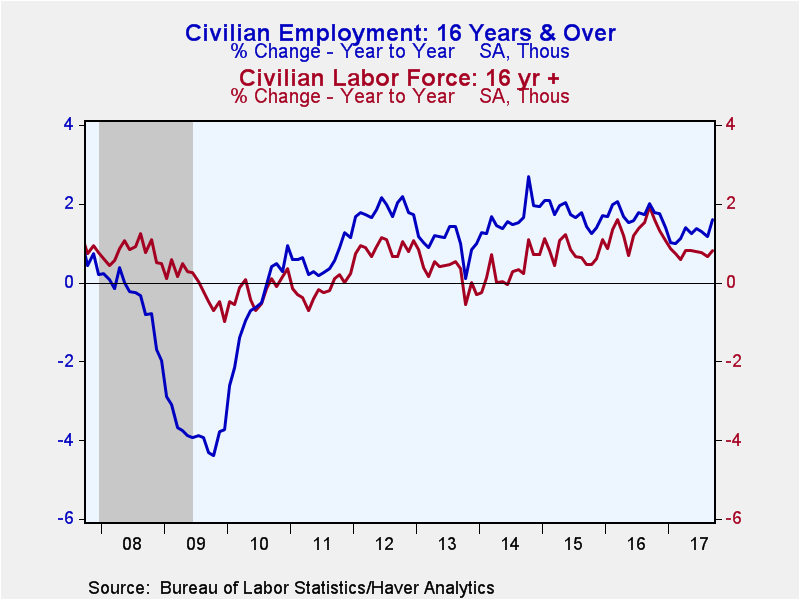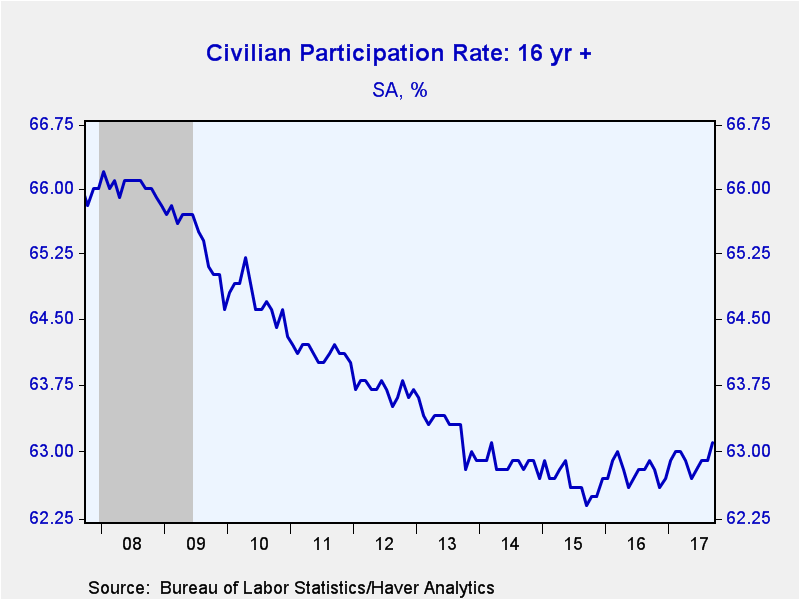 Global| Oct 06 2017
Global| Oct 06 2017U.S. Payrolls Battered by Hurricane Effects; Unemployment Rate Falls While Wages Strengthen
by:Tom Moeller
|in:Economy in Brief
Summary
The government's jobs numbers will be tough to read for a time as the economy deals with hurricane effects. Nonfarm payrolls declined 33,000 (+1.2% y/y) during September following a 169,000 August increase and a 138,000 July gain. [...]
The government's jobs numbers will be tough to read for a time as the economy deals with hurricane effects. Nonfarm payrolls declined 33,000 (+1.2% y/y) during September following a 169,000 August increase and a 138,000 July gain. Together these two figures were revised down by 38,000. An 87,000 jobs increase had been expected in the Action Economics Forecast Survey. Last month's employment decline centered in the leisure & hospitality sector where hiring fell 111,000. The unemployment rate declined sharply to 4.2% from 4.4%. An unchanged level had been expected. The overall unemployment rate, including the marginally attached and those working part-time for economic reasons, fell to 8.3%. Average hourly earnings increased 0.45% (2.9% y/y). A 0.3% gain had been expected.
From the payroll employment survey, the 33,000 jobs decline was led by leisure & hospitality, but factory sector jobs also fell by 1,000 (+1.0% y/y), the second decline in three months. Construction sector employment rose a modest 8,000 (2.5% y/y) after a 12,000 monthly average, January through August. Employment in the mining sector improved 2,300 (10.1% y/y), down from earlier increases as strong as 10,500 in February.
Within the decline in leisure & hospitality employment, restaurant jobs fell 104,700 (+1.4% y/y). Slower jobs growth was posted elsewhere. Education & health services rose by a reduced 27,000 (2.1% y/y) after a 45,000 increase which was typical of the increases earlier this year. Professional & business services employment gained just 13,000 (2.6% y/y), off versus the 35,000 to 59,000 monthly pace earlier this year. Showing little effect was the trade, transportation and utility area where employment increased 26,000 (0.3% y/y), the strongest increase since January. Financial activities employment rose 10,000 (1.8% y/y), on a par with the 12,000 monthly average earlier this year. Continuing lower was the number of information services jobs which were off 9,000 (-2.8% y/y), the largest decline since April. Government sector employment increased 7,000 (0.2% y/y), up slightly from its earlier pace. Federal government jobs held steady (-0.1% y/y). State government jobs rose a stable 2,000 (0.1% y/y) and local area employment gained a steady 5,000 (0.3% y/y).
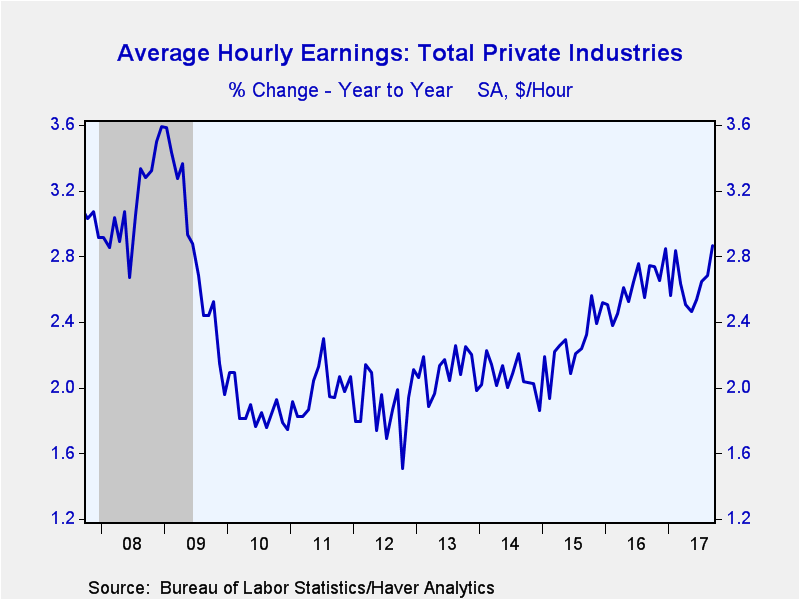 The jump in average hourly earnings was lifted by a 0.7%
surge (3.0% y/y) in the construction sector and a 0.5% rise (2.0% y/y) in
manufacturing. Private service producing earnings also increased 0.5% (2.9% y/y)
as information sector earnings jumped 1.1% (5.2% y/). Also strong was the 0.7%
rise (3.3% y/y) in professional & business services. Leisure &
hospitality earnings gained 0.4% (3.6% y/y). Education & health service
earnings rose a steady 0.2% (2.4% y/y).
The jump in average hourly earnings was lifted by a 0.7%
surge (3.0% y/y) in the construction sector and a 0.5% rise (2.0% y/y) in
manufacturing. Private service producing earnings also increased 0.5% (2.9% y/y)
as information sector earnings jumped 1.1% (5.2% y/). Also strong was the 0.7%
rise (3.3% y/y) in professional & business services. Leisure &
hospitality earnings gained 0.4% (3.6% y/y). Education & health service
earnings rose a steady 0.2% (2.4% y/y).
The length of the average workweek held steady m/m at 34.4 hours, but that's down from the January 2016 peak of 34.6 hours, where it had been during much of 2015. Private service-producing hours held steady m/m at 33.2 hours, but that was down versus the 2015 average of 33.4. The financial workweek held steady m/m at a reduced 37.5 hours, but the information sector's workweek was improved at 36.3 hours. The education & health services workweek dropped to 32.8 hours from 32.9 averaged last year. The leisure & hospitality workweek was steady m/m at 26.0 hours, down from 26.2 during all of 2015.
From the household employment survey, the decline in the unemployment rate to 4.2% left it at the lowest level since February 2001. Employment rose 0.6% (1.6% y/y). The size of the labor force increased 0.4% (0.8% y/y) versus a 0.1% gain (0.6% y/y) in the size of the population. The labor force participation rate rose to 63.1%, its highest level in four years.
The average duration of unemployment jumped to 26.8 weeks, the highest level since October 2016. The median duration of unemployment fell to 10.3 weeks. The percentage of workers unemployed for 15 weeks or more was 39.7%, but those jobless for 52 weeks or longer was 16.8%.
By educational attainment, the unemployment rate for those with less than a high school diploma was 6.5%, down from 8.4% twelve months earlier. For high school graduates with no college, the rate of 4.3% compared to 5.5% last October. Those with less than a college degree realized 3.6% joblessness compared to 4.2% a year earlier. College graduates were 2.3% unemployed versus last year's high of 2.7%.
The teenage unemployment rate dropped to 12.9% from the 25.9% averaged in 2010. For those aged 20-24 years, the rate rose slightly m/m to 7.5%, but remained below the 2010 average of 15.5%. Individuals aged 25-54 years old were 3.6% unemployed versus the 2010 high of 8.6%. Those over 55 were 3.2% jobless versus 7.0% in 2010.
Promise and Peril: Managing the Uncertainty of Rapid Innovation and a Changing Economy from the Federal Reserve Bank of Chicago can be found here.
The labor market data are contained in Haver's USECON database. Detailed figures are in the EMPL and LABOR databases. The expectations figure is in the AS1REPNA database.
| Employment: (SA, M/M Change, 000s) | Sep | Aug | Jul | Sep Y/Y | 2016 | 2015 | 2014 |
|---|---|---|---|---|---|---|---|
| Payroll Employment | -33 | 169 | 138 | 1.2% | 1.7% | 2.1% | 1.9% |
| Previous | -- | 156 | 189 | -- | -- | -- | -- |
| Manufacturing | -1 | 41 | -11 | 1.0 | 0.1 | 1.2 | 1.4 |
| Construction | 8 | 19 | -9 | 2.5 | 3.9 | 5.0 | 5.0 |
| Private Service-Producing | -49 | 98 | 153 | 1.4 | 2.1 | 2.4 | 2.1 |
| Government | 7 | 5 | 5 | 0.2 | 0.9 | 0.7 | 0.1 |
| Average Weekly Hours - Private Sector | 34.4 | 34.4 | 34.5 | 34.4 | 34.4 | 34.5 | 34.5 |
| Private Sector Average Hourly Earnings (%) | 0.5 | 0.2 | 0.5 | 2.9 | 2.6 | 2.3 | 2.1 |
| Unemployment Rate (%) | 4.2 | 4.4 | 4.3 | 4.9 | 4.8 | 5.3 | 6.2 |
Tom Moeller
AuthorMore in Author Profile »Prior to joining Haver Analytics in 2000, Mr. Moeller worked as the Economist at Chancellor Capital Management from 1985 to 1999. There, he developed comprehensive economic forecasts and interpreted economic data for equity and fixed income portfolio managers. Also at Chancellor, Mr. Moeller worked as an equity analyst and was responsible for researching and rating companies in the economically sensitive automobile and housing industries for investment in Chancellor’s equity portfolio. Prior to joining Chancellor, Mr. Moeller was an Economist at Citibank from 1979 to 1984. He also analyzed pricing behavior in the metals industry for the Council on Wage and Price Stability in Washington, D.C. In 1999, Mr. Moeller received the award for most accurate forecast from the Forecasters' Club of New York. From 1990 to 1992 he was President of the New York Association for Business Economists. Mr. Moeller earned an M.B.A. in Finance from Fordham University, where he graduated in 1987. He holds a Bachelor of Arts in Economics from George Washington University.



